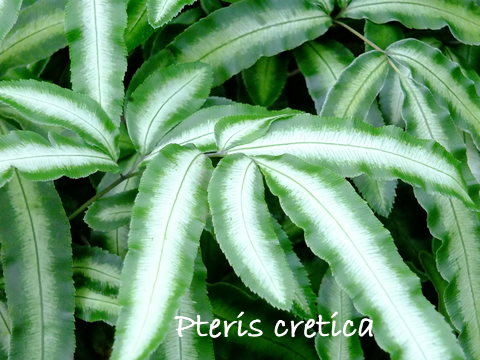Pteris cretica: Brake Fern Houseplant
Botanical Name: Pteris cretica and other species
Brake Fern is an elegant, small house plant that's easy to grow. In fact, it's so adaptable to living indoors, it has earned another common name: Table Fern.
Find out how to water, when to repot, and how much light will keep it healthy indoors.
 Pteris cretica var. albolineata makes a handsome plant. ©Claudiaholzmann
Pteris cretica var. albolineata makes a handsome plant. ©ClaudiaholzmannGet to Know Your Houseplant
Pteris is easier to please indoors than some other ferns. Brake Fern does require bright light, so don't put it in a dark corner. Set this handsome foliage plant on a table or plant stand near a window to give it the sunlight it craves.
Its fronds are somewhat fragile, so it's a good idea to keep this fern where passersby won't brush against its foliage.
Pteris cretica is long-lived and gaining in popularity as a house plant. This decorative fern has an interesting shape and unusual foliage, making it a beautiful addition to any brightly lit room.
Brake Fern Varieties
Many different varieties are available and they vary in leaf shapes and variegations. There are dozens of cultivars available. Choose what tickles your fancy -- all make captivating accents for a room.
- Pteris cretica 'Albolineata' sports creamy white stripes down the center of its leaflets.
- P. ensiformis 'Victoriae' has silvery white stripes, giving it the common name Silver Brake Fern.
- P. Cretica 'Cristata' has long, slender leaflets with frilly tips.
Brake Fern Problems, Solutions and Answers
Brown leaf tips? This isn't uncommon. You can help prevent it by boosting the humidity for your fern. (See "Humidity" tips below.)
Drooping, wilted fronds are likely caused by underwatering. It's a good idea to use a container with drainage holes so you can water your fern thoroughly, avoiding any dry pockets in the soil.
Pale leaflets are a symptom of too much sunlight. Move your houseplant away from the window. Don't worry about this -- your Brake Fern will green up again after a few weeks in a shadier spot.
Repot in spring, only when it gets too crowded. Brake Fern is slow-growing and prefers to be pot-bound. Keep the crown of the plant above the soil line when repotting. Don't pack the soil down; this fern likes a little air around its roots. Use a pot with a drainage hole to avoid soggy soil.
Something bugging your plant? Scale insects tend to favor ferns. You can remove scale by scraping them off. If the fronds are badly infested, cut them off. Don't use an insecticide on ferns because their fragile fronds are easily damaged.
Prune it. Keep it compact by cutting off tall fronds at the base. New ones will grow to take their place.
Keep it cool. Cool nights and moist air will keep this small fern healthy indoors. Hot, dry air will make the fronds turn yellow. Cut off yellow fronds at the base.
Are Pteris spp. poisonous? No, you can grow this one indoors worry-free. It's non-toxic to people and pets.
Brake Fern Care Tips
Origin: Southern Mediterranean
Height: 6-in to 2-ft (15 cm - 60 cm), depending on the variety
Light: Give your fern bright (indirect) light year-round. It also thrives under fluorescent light.
Water: Keep the potting mix lightly moist at all times. This Mediterranean fern needs slightly less water than its rainforest cousins, so take care not to overwater. Soggy potting medium will lead to root rot.
Humidity: Prefers 50% relative humidity. When indoor air gets dry in winter, set pot on a tray of wet pebbles or use a cool-mist room humidifier.
Temperature: Cool nights (50-55°F/10-13°C) and warm days (60-70°F/16-21°C) will make Pteris cretica feel at home.
Soil: Any good-quality potting mix with added perlite for good drainage.
Fertilizer: Brake ferns aren't heavy feeders, but they do need a regular weak water-soluble fertilizer during the growing season. Feed every 2 weeks spring through fall with a balanced house plant fertilizer at half the manufacturer's recommended strength.
Propagation: Division. Divide large plants in spring only when crowded; this fern is slow-growing and rarely needs divided.


